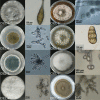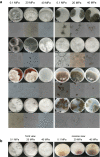High hydrostatic pressure shapes the development and production of secondary metabolites of Mariana Trench sediment fungi
- PMID: 34075128
- PMCID: PMC8169743
- DOI: 10.1038/s41598-021-90920-1
High hydrostatic pressure shapes the development and production of secondary metabolites of Mariana Trench sediment fungi
Abstract
The hadal biosphere is one of the least understood ecosystems on our planet. Recent studies have revealed diverse and active communities of prokaryotes in hadal sediment. However, there have been few studies on fungi in hadal sediment. Here we report the first isolation and cultivation of 8 fungi from the Mariana Trench sediment. The individual colonies were isolated and identified as Stemphylium sp., Cladosporium sp., Arthrinium sp., Fusarium sp., Alternaria sp., and Aspergillus sp. High hydrostatic pressure (HHP) test was carried out to identify the piezophily of these hadal fungi. Among them, 7 out of the 8 fungal isolates exhibited the ability of germination after incubation under 40 MPa for 7 days. Vegetative growth of the isolates was also affected by HHP. Characterization of secondary metabolites under different pressure conditions was also performed. The production of secondary metabolites was affected by the HHP treatment, improving the potential of discovering novel natural products from hadal fungi. The antibacterial assay revealed the potential of discovering novel natural products. Our results suggest that fungal growth pressure plays an important role in the development and production of secondary metabolites of these hadal fungi under the extreme environment in the Mariana Trench.
Conflict of interest statement
The authors declare no competing interests.
Figures






References
-
- Horikoshi M, Fujita T, Ohta S. Benthic associations in bathyal and hadal depths off the Pacific coast of north eastern Japan: physiognomies and site factors. Prog. Oceanogr. 1990;24:331–339. doi: 10.1016/0079-6611(90)90042-Z. - DOI
-
- Xu Y, Ge H, Fang J. Biogeochemistry of hadal trenches: Recent developments and future perspectives. Deep-Sea Res. Pt. II. 2018;155:19–26. doi: 10.1016/j.dsr2.2018.10.006. - DOI
Publication types
MeSH terms
LinkOut - more resources
Full Text Sources
Medical

